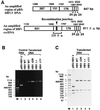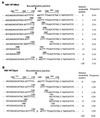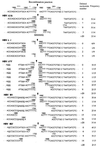The binding site of transcription factor YY1 is required for intramolecular recombination between terminally repeated sequences of linear replicative hepatitis B virus DNA
- PMID: 11000216
- PMCID: PMC112376
- DOI: 10.1128/jvi.74.20.9471-9478.2000
The binding site of transcription factor YY1 is required for intramolecular recombination between terminally repeated sequences of linear replicative hepatitis B virus DNA
Abstract
In the replication cycle of hepadnavirus DNA, the double-stranded linear form of viral DNA is generated as a minor replicative intermediate, which is efficiently converted to covalently closed circular DNA (cccDNA) by intramolecular recombination (W. Yang and J. Summers, J. Virol. 69:4029-4036, 1995). We previously found a binding site of transcription factor Yin and Yang 1 (YY1) in one terminal region of the double-stranded linear replicative hepatitis B virus (HBV) DNA (M. Nakanishi-Matsui, Y. Hayashi, Y. Kitamura, and K. Koike, J. Virol. 74:5562-5568, 2000). However, it is not known whether the YY1-binding site is required for the intramolecular recombination of HBV DNA. In this study, we established an HBV-producing system in which the cccDNA appeared to be generated from the transfected linear DNA or the linear replicative DNA by nonhomologous end joining (NHEJ) or by both NHEJ and homologous recombination between terminally repeated sequences, respectively. When the YY1-binding site in the terminal region of transfected linear viral DNA was mutated, the cccDNA was generated merely by NHEJ. Results suggest that the YY1-binding site in the terminal region of linear replicative HBV DNA is required for intramolecular recombination between terminally repeated sequences.
Figures







Similar articles
-
Integrated hepatitis B virus DNA preserves the binding sequence of transcription factor Yin and Yang 1 at the virus-cell junction.J Virol. 2000 Jun;74(12):5562-8. doi: 10.1128/jvi.74.12.5562-5568.2000. J Virol. 2000. PMID: 10823863 Free PMC article.
-
Replicative activity of hepatitis B virus is negatively associated with methylation of covalently closed circular DNA in advanced hepatitis B virus infection.Intervirology. 2011;54(6):316-25. doi: 10.1159/000321450. Epub 2011 Jan 14. Intervirology. 2011. PMID: 21242658
-
[An in vitro model of hepatitis B virus gene replication and expression in primary rat hepatocytes transfected with circular viral DNA].Zhonghua Gan Zang Bing Za Zhi. 2002 Aug;10(4):275-8. Zhonghua Gan Zang Bing Za Zhi. 2002. PMID: 12223138 Chinese.
-
A Role for the Host DNA Damage Response in Hepatitis B Virus cccDNA Formation-and Beyond?Viruses. 2017 May 22;9(5):125. doi: 10.3390/v9050125. Viruses. 2017. PMID: 28531167 Free PMC article. Review.
-
Novel therapeutic approaches for hepatitis B virus covalently closed circular DNA.World J Gastroenterol. 2015 Jun 21;21(23):7084-8. doi: 10.3748/wjg.v21.i23.7084. World J Gastroenterol. 2015. PMID: 26109795 Free PMC article. Review.
Cited by
-
Host Transcription Factors in Hepatitis B Virus RNA Synthesis.Viruses. 2020 Jan 30;12(2):160. doi: 10.3390/v12020160. Viruses. 2020. PMID: 32019103 Free PMC article. Review.
-
Hepatitis B virus cccDNA: Formation, regulation and therapeutic potential.Antiviral Res. 2020 Aug;180:104824. doi: 10.1016/j.antiviral.2020.104824. Epub 2020 May 22. Antiviral Res. 2020. PMID: 32450266 Free PMC article. Review.
-
Viral oncogene EBNALP regulates YY1 DNA binding and alters host 3D genome organization.EMBO Rep. 2025 Feb;26(3):810-835. doi: 10.1038/s44319-024-00357-6. Epub 2025 Jan 2. EMBO Rep. 2025. PMID: 39747661 Free PMC article.
-
Yin-Yang 1 and HBx protein activate HBV transcription by mediating the spatial interaction of cccDNA minichromosome with cellular chromosome 19p13.11.Emerg Microbes Infect. 2020 Dec;9(1):2455-2464. doi: 10.1080/22221751.2020.1840311. Emerg Microbes Infect. 2020. PMID: 33084547 Free PMC article.
-
Therapeutic interventions aimed at cccDNA: unveiling mechanisms and evaluating the potency of natural products.Front Cell Infect Microbiol. 2025 Jun 17;15:1598872. doi: 10.3389/fcimb.2025.1598872. eCollection 2025. Front Cell Infect Microbiol. 2025. PMID: 40599653 Free PMC article. Review.
References
-
- Ganem D. Hepadnaviridae and their replication. In: Fields B N, Knipe P M, Howley P M, editors. Fields virology. Philadelphia, Pa: Lippincott-Raven Publishers; 1996. pp. 2703–2737.
-
- Knowles B B, Howe C C, Aden D P. Human hepatocellular carcinoma cell lines secrete the major protein and hepatitis B surface antigen. Science. 1980;209:497–499. - PubMed
MeSH terms
Substances
LinkOut - more resources
Full Text Sources

